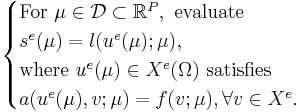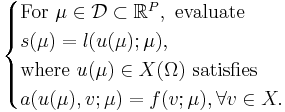| Line 44: | Line 44: | ||
<math> |
<math> |
||
| − | a(w,v;\mu) = \sum_{q=1}^Q \Theta_a^q(\mu) a^q(w,v) |
+ | a(w,v;\mu) = \sum_{q=1}^Q \Theta_a^q(\mu) a^q(w,v) |
| + | </math> |
||
| + | |||
| + | <math> |
||
f(v;\mu) = \sum_{q=1}^{Q^f} \Theta_f^{q}(\mu) f^q(v). |
f(v;\mu) = \sum_{q=1}^{Q^f} \Theta_f^{q}(\mu) f^q(v). |
||
</math> |
</math> |
||
Revision as of 15:30, 19 November 2012
The Reduced Basis Method (RBM) we present here is applicable to static and time-dependent linear PDEs.
Time-Independent PDEs
The typical model problem of the RBM consists of a parametrized PDE stated in weak form with
bilinear form  and linear form
and linear form  .
The parameter
.
The parameter  is considered within a domain
is considered within a domain  and we are interested in an output quantity
and we are interested in an output quantity  which can be
expressed via a linear functional of the field variable
which can be
expressed via a linear functional of the field variable  .
.
The exact, infinite-dimensional formulation, indicated by the superscript e, is given by

We assume a large-scale discretization to be given, such that we consider

The underlying assumption of the RBM is that the parametrically induced manifold  can be approximated by a low dimensional space
can be approximated by a low dimensional space  .
.
It also applies the concept of an offline-online decomposition, in that a large pre-processing offline cost is acceptable in view of a very low online cost (of a reduced order model) for each input-output evaluation, when in a many-query or real-time context.
The essential assumption which allows the offline-online decomposition is that there exists an affine parameter dependence


The Lagrange Reduced Basis space is established by iteratively choosing Lagrange parameter samples 
and considering the associated Lagrange RB spacesin a greedy sampling. This leads to hierarchical RB spaces:
.
